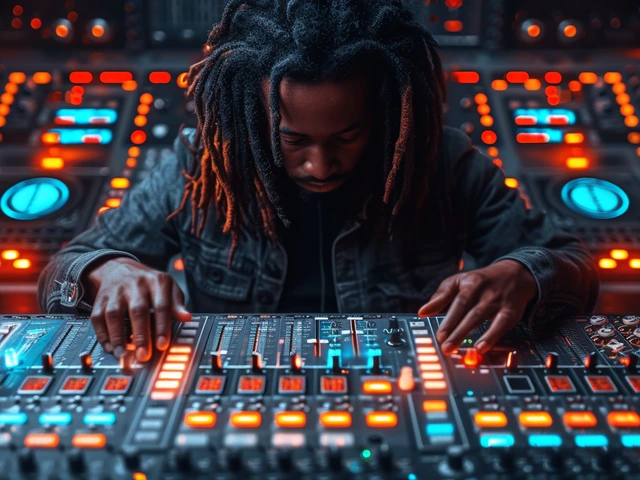Imagine being able to pitch your idea not just to the people in your city but to anyone, anywhere, with just a click. This isn’t a fantasy—it’s the pulse of internet marketing today. In 2025, the speed at which brands reach new audiences is mind-blowing. The old gatekeepers and their velvet ropes vanished the day people started buying shoes from their couches, scrolling through sponsored TikToks at midnight, and following indie skincare brands from three continents away. Internet marketing doesn't just open doors; it smashes down walls that used to block small players, local shops, and new ideas. Everyone’s got a shot now. Even if you’ve never owned a suit, you can run a global business from your kitchen counter—if you learn the ropes and play smart.
How the Internet Changed Traditional Marketing Rules
Back in the day, marketing was a mix of luck and deep pockets. Either you slapped your ad on a billboard, hoped it caught someone's eye, or paid a small fortune for a few seconds on TV. Getting seen meant coughing up for an ad agency or hiring a PR rep. Small businesses played by the big players’ rules or got sidelined. Then came the internet and things flipped. Suddenly, you could reach thousands with a viral tweet or an honest product review. For context: in 2000, global online ad spending scraped by at $8 billion. Fast forward to 2024? It exploded past $600 billion. It's wild: over 5.3 billion people now use the internet (that's around two-thirds of the planet). Every minute, internet users generate more than 4.3 million Google searches, watch over 5 million YouTube videos, and spend nearly $1 million shopping online.
Today, you don’t need endless funds to get noticed. Take Dollar Shave Club—they kicked things off with one cheeky, low-budget video in 2012 and rolled up a subscriber list that made Gillette sweat for years. Social platforms have leveled the playing field for brands and creators alike. Instagram lets local bakers in small towns pop up in the feeds of folks across the world alongside Fortune 500 food giants. TikTok’s algorithm famously shot unrecognized creators to overnight stardom with a single clever video. Here’s the truth: if you craft a message that rings authentic, the right tools can help it echo far and wide.
Look at influencer marketing—a smart twist on an old strategy. It blends word-of-mouth power with global reach. And it’s fast: a single post by a micro-influencer can drive a thousand clicks in seconds. Most brands, big or small, no longer talk at people. They talk with them. Digital marketing is interactive and measurable: you see which ads get clicked, what emails people open, and where they bounce. That feedback means campaigns can be tweaked in real-time rather than waiting months to see if the billboard worked. You adjust, improve, and meet your audience’s needs on the fly, instead of guessing and gambling.
| Year | Global Digital Ad Spend | Internet Users Worldwide |
|---|---|---|
| 2000 | $8B | 400M |
| 2010 | $65B | 1.9B |
| 2020 | $350B | 4.5B |
| 2024 | $600B | 5.3B |
Emerging tech, like artificial intelligence, gives brands tools small teams could only dream of—automatic chatbots, tailored email campaigns, and super-precise audience targeting. But here’s the kicker: digital marketing didn’t just change how brands talk; it changed who gets to talk. Now, even the smallest side hustle can find its crowd and build a loyal tribe, all without a single glossy billboard or prime-time ad.
Barriers Broken: Internet Marketing’s Biggest Wins
Maybe you’ve watched an unknown singer blow up on Spotify in weeks or seen a gadget from a two-person startup pop up on your Netflix feed. That’s internet marketing tearing down barriers. Geography? Barely relevant now. A surf brand from Norway can be bigger in Brazil than at home, just by targeting the right hashtags and sharing stories that vibe with beach lovers worldwide. Language? AI-driven translations and subtitled videos chip away that wall, letting brands chat with customers across dozens of languages instantly.
Money used to be the biggest hurdle. Now, $20 can run a hyper-targeted Instagram ad. Small businesses can test ideas fast—if an ad flops, pivot the next day. If a meme about your new café’s bagels blows up, you’re suddenly ‘the bagel spot’ everywhere. Brands have learned to use micro-influencers, those creators with smaller but fiercely loyal followings, to build hard-to-break customer trust. In fact, consumers trust peer recommendations 90% more than ads from brands themselves.
Retailers who once dreamed of franchising can go global with a Shopify store and a clever TikTok strategy. A Brooklyn artist, for example, launched her prints on Etsy, built an Instagram following, and now ships to buyers from as far away as Japan and Germany without ever leaving her neighborhood. Nonprofits, too, have shattered fundraising ceiling—remember the ALS Ice Bucket Challenge? No agency could’ve engineered that viral storm, but internet marketing made it happen, raising $115 million in eight weeks.
People with physical disabilities, limited startup cash, or niche interests now find communities and customers. Makers of adaptive tech find global fans through Facebook groups. Plant lovers, bookworms, and Star Wars collectors gather on Discord and Reddit, where even the most specific obsessions turn profitable. Smart brands embrace this, niching down, listening actively, and designing experiences tailored to micro-communities. Digital word-of-mouth can bring in customers or donors within minutes, unlike slow and expensive print or billboard campaigns of the past.
What’s wild—teenagers with social savvy, sharp storytelling, and zero business school credits regularly produce product launches as effective as decades-old brands. The digital revolution means anyone, backed by passion and the right approach, can break into markets previously reserved for big spenders or lucky insiders.

Smart Internet Marketing: Real-World Tips that Work
So, how do you actually break barriers yourself? You start by mapping out exactly who you want to reach. Skip the old “everyone is a customer” myth. Use analytics tools—Google Analytics, Facebook Insights, or TikTok Creator Center—to zoom in on age, interests, habits, and even what time your audience is most active. The more personal your message feels, the more likely people are to pause, engage, and remember. For small businesses, set aside a few hours each week to engage directly with your community. Ask questions on Instagram Stories, respond publicly to both good and bad reviews, and join in on trending discussions tied to your niche.
Content is still king, but only if it’s relevant, creative, and sharp. Mix formats: videos, infographics, behind-the-scenes stories, user-generated content, and even silly memes. Track what clicks—use A/B testing for subject lines or visuals, and keep the winners. When creating ads, use simple language. Research from HubSpot shows that emails written at a third-grade reading level get up to 53% higher response rates than those packed with formal or complex language. If your word choice is natural and conversational, your audience will trust you more—plus, those emails and posts get shared further.
Don’t post and ghost. Social platforms reward engagement. The more you like, share, and reply to comments, the higher your posts show up in feeds. Consistency beats brilliance here. A steady trickle of thoughtful posts, memes, or product updates outperforms one viral hit, then silence. And remember, trends change fast. What worked on Facebook five years ago might flop on Instagram Reels or Snapchat today. Keep an eye on analytics, and don’t fear changing your strategy when something feels stale.
- Use automation tools for scheduling posts and sending out emails, but keep real-time engagement genuine and human.
- Run regular polls and Q&As. They spike engagement and show you’re listening.
- Influencers can be gold, but choose ones who genuinely like your product, not just anyone with a huge following.
- Measure everything—clicks, likes, shares, website visits, and the path new customers take after seeing your ad.
- Turn mistakes into stories; people connect more with imperfect, honest brands.
The secret sauce? Blend automation and data smarts with the things humans do best—empathy, humor, and creativity. Look to tools like Canva for design, Hootsuite for scheduling, and Mailchimp for emails, but layer on your one-of-a-kind voice above all. Authenticity scales beautifully online.
Here’s a quick peek at how brands track and use digital marketing:
| Tool | Use Case | Fun Fact |
|---|---|---|
| Google Analytics | Tracks website activity | Over 55% of top sites use it |
| Hootsuite | Social media scheduling | Supports 35+ platforms |
| Canva | Design for non-designers | 200M+ designs made monthly |
| Mailchimp | Email campaigns | Delivers over 1B emails daily |
The Future: Where Internet Marketing Pushes Brand Boundaries Next
So, what’s on the horizon? AI’s role in marketing keeps pushing new envelopes. Chatbots already answer customer questions faster than most humans can, and next-gen personalization means every email, ad, and homepage you see can be crafted just for you. Augmented reality (AR) lets beauty shoppers try on lipstick virtually; furniture customers can picture a new couch in their living room before buying. By 2025, AR-powered ads are expected to double engagement rates compared to plain images.
Voice search is rewriting SEO rules. Products now have to think about how people ask Siri or Alexa a question, not just what they type into Google. Strategies are shifting from “best running shoes” to “what’s the comfiest sneaker for my morning jog?” This subtle change means brands need to be more conversational, less robotic in their messaging. Privacy rules are also shaking things up. Marketers are racing to respect growing demands for online privacy—more people say no to tracking cookies. Smart brands build trust by being clear about how they use data and only collecting what’s necessary.
The rise of live streaming — for everything from shopping to Q&As to sneak peeks behind the scenes — is proving huge for brand loyalty. On platforms like Twitch, YouTube, and TikTok, brands sell “live” and interact instantly, crushing the old barrier of distance and cold, static ads. Collaborations with creators and even cross-brand partnerships keep things fresh and build surprise buzz that gets noticed.
Gen Z and Gen Alpha expect brands to listen and engage, not just broadcast ads. Storytelling is at the core—your values, your process, even your fails. More companies share real, unedited stories of staff, customers, and product mishaps. Brands that didn’t exist a year ago can now earn a social following faster than some legacy businesses grow in a decade.
Want to stay competitive? Keep learning. Follow digital marketing newsletters, join lively online groups, and test new trends early—brands that adapt survive and thrive. The key lesson: internet marketing launched an era where creativity, curiosity, and authenticity break boundaries every single day. Anyone can rise if they're willing to listen, learn, tweak, and connect.
There’s never been a better time to power up your digital marketing game—because the next barrier could be one you break.





